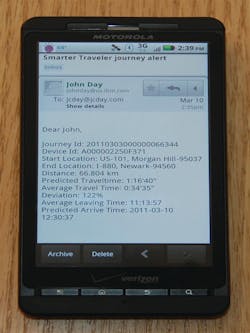IBM, Caltrans and UC Berkeley Aim to Help Commuters Avoid Congested Roadways Before their Trip Begins
IBM announced a new collaboration with the California Department of Transportation (Caltrans) and California Center for Innovative Transportation (CCIT), a research institute at the University of California, Berkeley, to develop an intelligent transportation solution that will help commuters avoid congestion and enable transportation agencies to better understand, predict and manage traffic flow.
In a technology advance that will ultimately help drivers around the world avoid rush hour traffic jams, IBM Research has developed a new predictive modeling tool that will allow drivers to quickly access personalized travel recommendations to help them avoid congestion, and save time and fuel.
By joining forces, IBM, Caltrans and the Mobile Millennium team within CCIT hope to provide drivers with valuable predictive information on what traffic patterns are likely to look like – even before they leave work or home and get in their vehicles – rather than discover what has already happened and is being reported.
Using this predictive and analytic traffic tool, transportation agencies and city planners in the future will be able to proactively design, manage and optimize transportation systems to more seamlessly handle the ever-increasing traffic that results from population growth and increasing urbanization.
“As the number of cars and drivers in the Bay Area continue to grow, so too has road traffic. However, it’s unrealistic to think we can solve this congestion problem simply by adding more lanes to roadways, so we need to proactively address these problems before they pile up,” said Greg Larson, chief of the Office of Traffic Operations Research, Caltrans. “Together with partners like CCIT and IBM we’re driving a new age of science-based, data-centric traffic management that will give commuters the benefit of knowing the fastest, most cost-effective and eco-friendly route to their destination.”
Traffic delays caused by highway incidents such as work zones, crashes or simply by morning and evening rush hours routinely stymie frustrated drivers. Even with advances in GPS navigation, real-time traffic alerts and mapping, daily commute times are often unreliable, and relevant updates on how to avoid congestion often reach commuters when they are already stuck in traffic and it is too late to change course. This inability to avoid traffic congestion has led to commuters across the United States wasting an average of a week's worth of time, 28 gallons of gas and $808 over the course of a year.
In Silicon Valley, the problem is especially acute. In comparison with cities of a similar size in population, drivers in the city of San Jose waste a cumulative of 10 million more annual hours sitting in traffic jams and suffer a 15 percent higher commute delay per peak-time traveler.
Spanning the San Francisco Bay Area Region, the new Smarter Traveler Research Initiative collects and analyzes traffic data generated from existing sensors in roads, toll booths, bridges and intersections. This unique project combines that data with locations based on GPS sensors in participating people’s cell phones to learn their preferred travel days and routes. Alerts are then automatically delivered via email or text message on the status of the driver’s typical commute before the trip begins, which eliminates potential driver distraction once the trip is in progress.
These alerts will enable drivers to plan and share alternative travel routes, improve traveler safety and help transportation authorities better predict and reduce bumper-to-bumper traffic before congestion occurs through improved traffic signal timing, ramp metering and route planning.
The researchers will leverage a first-of-its-kind learning and predictive analytics tool called the IBM Traffic Prediction Tool (TPT), developed by IBM Research, which continuously analyzes congestion data, commuter locations and expected travel start times throughout a metropolitan region that can affect commuters on highways, rail-lines and urban roads. Through this Smarter Traveler Research Initiative, scientists could eventually recommend better ways to get to a destination, including directions to a nearby mass transit station, whether a train is predicted to be on time and whether parking is predicted to be available at the station.
“In order for intelligent transportation systems to be truly effective, travelers need information they can act upon before getting stuck in traffic,” said Stefan Nusser, Functional Manager, Almaden Services Research, IBM. “By actively capturing and analyzing the massive amount of data already being collected, we’re blending the automated learning of travel routes with state-of-the-art traffic prediction of those routes to create useful information that focuses on providing timely, actionable information to the traveler.”


